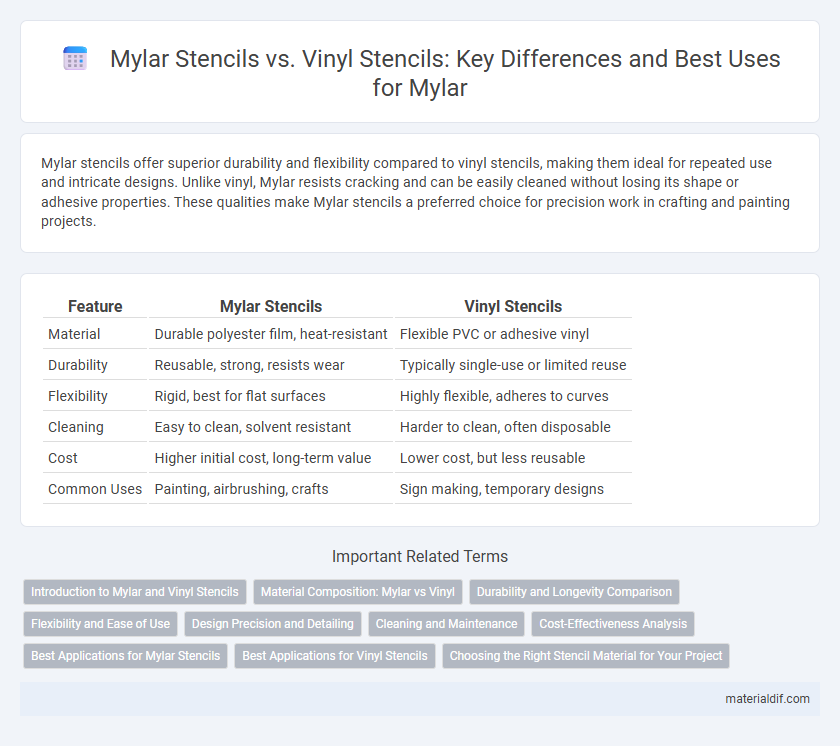Mylar stencils offer superior durability and flexibility compared to vinyl stencils, making them ideal for repeated use and intricate designs. Unlike vinyl, Mylar resists cracking and can be easily cleaned without losing its shape or adhesive properties. These qualities make Mylar stencils a preferred choice for precision work in crafting and painting projects.
Table of Comparison
| Feature | Mylar Stencils | Vinyl Stencils |
|---|---|---|
| Material | Durable polyester film, heat-resistant | Flexible PVC or adhesive vinyl |
| Durability | Reusable, strong, resists wear | Typically single-use or limited reuse |
| Flexibility | Rigid, best for flat surfaces | Highly flexible, adheres to curves |
| Cleaning | Easy to clean, solvent resistant | Harder to clean, often disposable |
| Cost | Higher initial cost, long-term value | Lower cost, but less reusable |
| Common Uses | Painting, airbrushing, crafts | Sign making, temporary designs |
Introduction to Mylar and Vinyl Stencils
Mylar stencils are made from durable polyester film known for its flexibility, transparency, and resistance to chemicals and tearing, making it ideal for repeated use in detailed painting or crafting projects. Vinyl stencils, crafted from adhesive-backed plastic, offer strong adherence to surfaces, enabling precise application and preventing paint bleed, but are typically less reusable than Mylar. Both stencil types serve distinct purposes: Mylar excels in durability and versatility for multi-use designs, while vinyl provides superior surface grip and crisp edges for one-time or short-term projects.
Material Composition: Mylar vs Vinyl
Mylar stencils are made from polyethylene terephthalate (PET), a durable polyester film known for its strength, flexibility, and resistance to heat and chemicals. Vinyl stencils consist of polyvinyl chloride (PVC), which offers adhesive properties and slight flexibility but is less resistant to heat and may degrade more quickly with repeated use. The superior material composition of Mylar makes it more suitable for precision artwork and repeated applications compared to the more disposable nature of vinyl stencils.
Durability and Longevity Comparison
Mylar stencils offer superior durability compared to vinyl stencils due to their polyester film composition, which resists tearing, stretching, and solvents. Their long-lasting flexibility maintains stencil shape and detail over repeated uses, making them ideal for projects requiring precision and consistency. In contrast, vinyl stencils tend to degrade faster, losing adhesion and shape after limited applications, especially when exposed to harsh paints or cleaning processes.
Flexibility and Ease of Use
Mylar stencils offer superior flexibility compared to vinyl stencils, allowing for easy application on curved or uneven surfaces without cracking or tearing. Their lightweight and durable polyester material makes them reusable and simple to clean, enhancing ease of use for detailed art and craft projects. Vinyl stencils tend to be thicker and less flexible, which can limit their adaptability but provide a solid, adhesive backing for smooth, flat surfaces.
Design Precision and Detailing
Mylar stencils offer superior design precision and intricate detailing due to their smooth, non-porous surface that resists ink bleed, ensuring sharp and clean edges in every application. Vinyl stencils, while flexible and easy to apply on curved surfaces, often lack the crisp detail achievable with Mylar because of their porous texture and slight stretch during use. For projects requiring high-definition patterns and fine lines, Mylar stencils are the preferred choice for consistent and professional results.
Cleaning and Maintenance
Mylar stencils provide superior durability and ease of cleaning compared to vinyl stencils, as their non-porous surface resists paint absorption and allows for quick rinsing with water or mild detergent. Vinyl stencils often trap paint within their textured surface, requiring more intensive scrubbing and frequent replacement due to wear. The reusability of Mylar stencils makes them a cost-effective and low-maintenance choice for artists and crafters.
Cost-Effectiveness Analysis
Mylar stencils offer a durable and reusable option, often costing more upfront but providing greater long-term savings due to their resistance to wear and easy cleaning. Vinyl stencils are typically cheaper initially and ideal for single-use projects, yet their disposability can lead to higher cumulative expenses over time. Evaluating project frequency and reusability needs is essential to determine the most cost-effective stencil material choice.
Best Applications for Mylar Stencils
Mylar stencils excel in applications requiring durability and precision, such as airbrushing, detailed painting, and fabric design, where repeated use and clean edges are essential. Their rigid yet flexible structure resists paint bleed-through and withstands cleaning solvents, making them ideal for industrial art and crafting projects. Unlike vinyl stencils, Mylar is better suited for complex patterns and surfaces needing consistent stencil integrity over time.
Best Applications for Vinyl Stencils
Vinyl stencils excel in applications requiring high durability and reusability, such as signage, vehicle graphics, and outdoor projects where weather resistance is critical. Their adhesive backing ensures precise placement on uneven surfaces, making them ideal for detailed designs on walls, glass, and wood. Unlike Mylar stencils, vinyl stencils are better suited for long-term use and can withstand multiple paint layers without losing their shape or integrity.
Choosing the Right Stencil Material for Your Project
Mylar stencils offer durability, flexibility, and reusability, making them ideal for intricate designs and repeated use in crafts or painting projects. In contrast, vinyl stencils provide strong adhesive properties for clean, sharp lines on smooth surfaces but are typically single-use and less flexible. Selecting the right stencil material depends on project requirements, surface type, and whether you need a reusable or disposable option.
Mylar Stencils vs Vinyl Stencils Infographic

 materialdif.com
materialdif.com